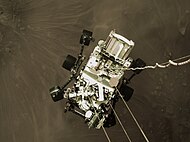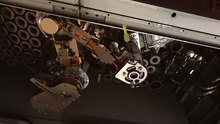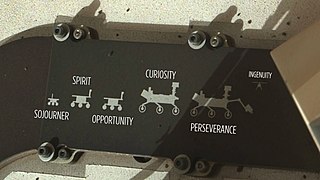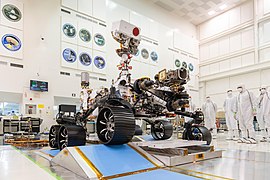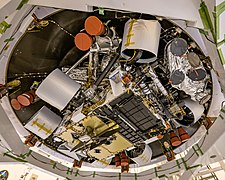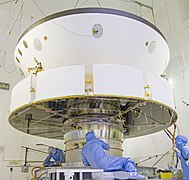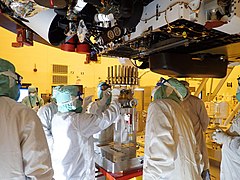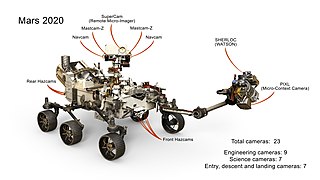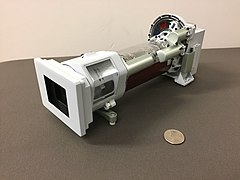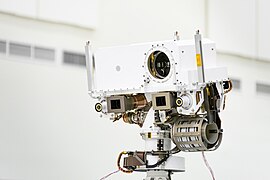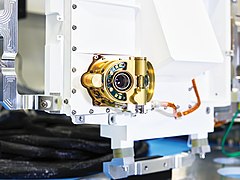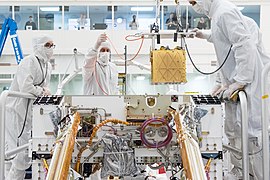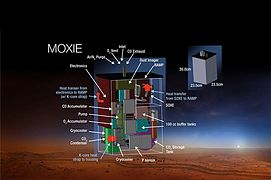Mars 2020
| Mars 2020 | ||||||||||||||||
|---|---|---|---|---|---|---|---|---|---|---|---|---|---|---|---|---|
| Phase : E / Status : active | ||||||||||||||||
 Selfie of the Rover Perseverance with the Ingenuity helicopter drone (near the Van Zyl survey on April 7, 2021)
|
||||||||||||||||
| Type: | Space probe ( rover ) | |||||||||||||||
| Country: |
|
|||||||||||||||
| Organization: | NASA and JPL (Jet Propulsion Laboratory) | |||||||||||||||
| COSPAR designation : | 2020-052A | |||||||||||||||
| Mission dates | ||||||||||||||||
| Start date: | July 30, 2020, 11:50 UTC | |||||||||||||||
| Starting place: |
Space Launch Complex 41 ( Cape Canaveral Air Force Station ) |
|||||||||||||||
| Launcher: | Atlas V 541 (AV-088) | |||||||||||||||
| Landing place: | Jezero crater | |||||||||||||||
| miscellaneous | ||||||||||||||||
| Previous mission: |
Mars Science Laboratory | |||||||||||||||
|
||||||||||||||||
Mars 2020 is NASA's fifth Mars rover and first helicopter mission . By means of an Atlas V - launcher was on July 30, 2020 from Cape Canaveral , a lander with the rover Perseverance ( German , perseverance endurance ) with its small helicopter Ingenuity ( ingenuity started) to 480 million km long flight to Mars. The probe landed on February 18, 2021 in the northern hemisphere of Mars in the Jezero crater .
Mission objectives, planning and process up to the start
The mission is part of NASA's Mars Exploration Program . Perseverance is to examine Martian rocks more closely with regard to biosignatures , geological processes and the geological history of the planet in order to gain insights into possible life on Mars, among other things . The $ 2.5 billion rover will also study the planet's climate. The mission also serves to prepare a manned flight to Mars . The rover will test convert carbon dioxide into oxygen and analyze these results. Mars 2020 was announced on December 4, 2012 during the American Geophysical Union's fall meeting in San Francisco. Scientific instruments for the rover were selected in an open competition after the mission objectives were announced. After over 60 suggestions had been received, NASA announced the landing of the rover in July 2014, which was to be designed similar to the Curiosity rover .
As a landing place a former, 3.5 billion years old was river delta in Jezero crater chosen that in the Syrtis Major Planitia at the coordinates 18 ° 51 '18 " N , 77 ° 31' 8.4" O is located and about 3 , 9 to 3.5 billion years ago was a 250 m deep lake. Old hydrothermal vents in the northeast of the Syrtis Major plateau and at the Columbia Hills were considered as alternatives .
In order for the Perseverance to get to Mars as sterile as possible - otherwise the rover could detect traces of life on Mars that it brought there itself - the assembly of the Perseverance was carried out in a clean room inside another clean room at the Jet Propulsion Laboratory .
As a carrier rocket for the launch of the spacecraft was Atlas V 541 selected. The rocket is 58 meters high and is adjacent to the first stage of four solid - boosters and a Centaur upperstage. The start window for the mission was set after a postponement to the period from July 30 to August 15, 2020; The launch site was launch pad 41 at Cape Canaveral Air Force Station in Florida .
- Planning progress - Mars 2020
Space capsule Mars 2020 a
Landing area - river delta in the Jezero crater
Structure and technology of the space probe compared to the Mars mission MSL
The structure of the space probe and the technology of the cruise flight and landing systems of Mars 2020 differ significantly from that of the Mars Science Laboratory (MSL) , especially with regard to the different rovers and the further developed descent stage .
The control and control technology of Mars 2020 has been improved compared to the Mars mission MSL in that, on the one hand, the landing stage of Mars 2020 was supplemented by the function of avoiding obstacles and, on the other hand, the deviation of the self-localization of the descent stage was reduced from 3 km to around 40 meters has been.
Mission progress
Flight to Mars
On the day it landed on Mars, the probe had covered a distance of 470 million kilometers in relation to the sun. The distance between Earth and Mars varies between 56 million kilometers and 401 million kilometers. The probe traveled a greater distance than the maximum distance between Earth and the slower orbiting Mars - the launch window is a compromise between flight time and propulsion energy. About 20 hours before landing, the travel speed (relative to the sun) of the probe was about 76,820 kilometers per hour .
Landing on Mars
The approach and landing on February 18, 2021 took place fully automatically due to the signal propagation time of around 11 minutes between Earth and Mars, as in previous missions ; the instructions for this were programmed into the probe and the rover. The descent stage was able to recognize obstacles and, if necessary, to change the landing site with sideways movements by up to 300 meters.
During and after the landing, which was confirmed at 8:55 p.m. ( UTC ) at JPL's Mission Control Center , the Mars Reconnaissance Orbiter spacecraft , which is connected to Earth via the Deep Space Network , flew over the landing site and served as a relay station . A few hours after landing, the Exomars Trace Gas Orbiter flew over the landing site and assumed the role of relay station. The Maven space probe , for its part, changed its course prior to the landing of Mars in 2020 in order to document the process with its instruments. The Mars Express monitors the local weather conditions during the mission.
First sound recordings from Mars
sound recordings from Mars for the first time on February 22, 2021 published.
First helicopter flight
On April 19, 2021, the Ingenuity helicopter drone flew for the first time on Mars for 30 seconds and reached an altitude of three meters. This was the first time that a helicopter flew on a strange planet.
Instruments of perseverance
In addition to 23 cameras, the rover is also equipped with two microphones , with which sounds from Mars could be transmitted for the first time. Although two previous NASA missions already had sound transducers on board, the landing of Mars Polar Lander failed and the microphone built into the camera of the Phoenix descent module was never activated.
(Duration: 2:20 min)
Mastcam-Z
Mastcam-Z is a panoramic and stereoscopic camera system with a zoom lens . The instrument will also determine the minerals on the surface of Mars and help with navigation. The instrument was developed by James Bell's group at Arizona State University in Tempe . It was built by Malin Space Science Systems in San Diego , California, among others . In addition to other US universities, the German Aerospace Center and the Austrian Joanneum Research GmbH were or are involved in the project.
SuperCam
SuperCam is an assembly of four spectrometers that are supposed to carry out analyzes of rocks and soils using laser-induced plasma spectroscopy . The Supercam can be used to search for organic compounds in stones and regoliths . It was developed to identify the biosignatures of microbes on Mars.
The instrument was mainly developed by a team from the Los Alamos National Laboratory in Los Alamos , New Mexico , but the French space agency (L'Institut de Recherche en Astrophysique et Planétologie [CNES / IRAP]) and research institutions at the universities of Hawaii and the Spanish University of Valladolid .
Planetary Instrument for X-ray Lithochemistry (PIXL)
The Planetary Instrument for X-ray Lithochemistry (PIXL) is an X-ray fluorescence spectroscope that is also equipped with a high-resolution camera and is intended to determine the elementary composition of the Martian surface. PIXL was developed by Abigail Allwood's team at the NASA Jet Propulsion Laboratory (JPL) in Pasadena , California.
Scanning Habitable Environments with Raman & Luminescence for Organics and Chemicals (SHERLOC)
Scanning Habitable Environments with Raman and Luminescence for Organics and Chemicals (Sherloc) is a spectrometer with ultraviolet - lasers the exact mineralogy and organic compounds to determine. SHERLOC is the first ultraviolet Raman spectrometer to fly to Mars. It was realized by Luther Beegle's team at NASA Jet Propulsion Laboratory (JPL) in Pasadena, California.
The Mars Oxygen ISRU Experiment (MOXIE)
The Mars Oxygen ISRU Experiment (MOXIE) is an instrument for researching a technology that electrochemically converts the carbon dioxide present in the Martian atmosphere into oxygen and carbon monoxide. After an analysis of its purity, the oxygen obtained is to be released back into the Martian atmosphere with the carbon monoxide. MOXIE was designed by the team at the Massachusetts Institute of Technology in Cambridge , Massachusetts .
Mars Environmental Dynamics Analyzer (MEDA)
The Mars Environmental Dynamics Analyzer (MEDA) consists of a series of sensors designed to record the optical properties of dust and six atmospheric parameters. The abbreviation MEDA also stands for ¡me da! (Spanish for "Give me!"), in the sense of: "Give me information about weather, dust, radiation!" The instruments were designed by a team from the Spanish Instituto Nacional de Técnica Aeroespacial .
On Mars, MEDA is to measure the size and quantity of dust particles as well as wind direction , wind speed , air pressure , relative humidity , air temperature , soil temperature , certain bandwidths of ultraviolet radiation , visible radiation and infrared radiation. The sensors belonging to MEDA are located on the top and front of the rover, as well as on the upper rear of the remote sensing mast and in its interior. They have a total weight of 5.5 kilograms.
The sensors of the MEDA
- RDS - radiation and dust sensor : Dimensions: 13.2 cm × 11.5 cm × 12.5 cm; on top of the rover, consisting of eight upward-facing photodiodes
- HS - humidity sensor : Dimensions: 5.5 cm × 2.5 cm × 7.25 cm; mounted on the remote sensing mast within a protective cylinder and surrounded by a dust filter
- TIRS - thermal infrared sensor (infrared sensor): Dimensions: 6.25 cm × 5.25 cm × 5.75 cm; on Remote Sensing mast mounted aligned on the front right side of the rover; consisting of three upward and two downward thermopiles
- ATS1-ATS5 - air temperature sensor 1-5 (air temperature sensors 1-5): Dimensions: 5.75 cm × 2.75 cm × 6.75 cm; three around the remote sensing mast , two more attached to the main part of the rover
- WS1 – WS2 - wind sensor 1–2 (wind sensors 1–2): Dimensions: wind sensor 1: 5 cm × 17 cm and wind sensor 2: 25 cm × 40 cm; attached to the remote sensing mast
- PS - pressure sensor (pressure sensor and control unit): Dimensions: 14 cm × 14 cm × 13 cm; mounted inside the rover with a pipe leading to the outside.
The Radar Imager for Mars' Subsurface Exploration (RIMFAX)
The Radar Imager for Mars' Subsurface Exploration (RIMFAX) is a ground penetrating radar that acquires a vertical profile every 10 cm of travel distance and thus provides a two-dimensional image of the subsurface during the journey, depending on the nature of the ground up to a depth of over 10 m. Based on the reflected and scattered radio waves, it analyzes the geological structure and density of the soil in order to, among other things, determine To be able to recognize rocks, meteorites or water ice and brine - the landing area is an impact crater, which is subsequently formed over by water and covered by sediment. The device works with radio waves with a frequency between 120 MHz and 1.2 GHz in order to have a high penetration depth at low frequencies and a high vertical resolution at high frequencies, depending on the nature of the ground. The instrument was developed by the Norwegian Defense Research Institute (Forsvarets forskningsinstitutt) around Svein-Erik Hamran. RIMFAX is the first ground penetrating radar to work directly on Mars and can provide more detailed data than was previously possible from the mass satellite. The name goes back to Hrímfaxi, a horse in Norse mythology.
Helicopter drone
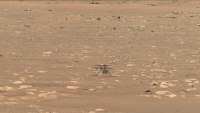
As part of the Mars 2020 mission, a helicopter drone was used for the first time on another celestial body, the Mars Helicopter , also known as Ingenuity . During the successful maiden flight of the drone on April 19, 2021, it reached the planned altitude of 3 m.
Ingenuity is operated with batteries charged from solar cells and was built from both specially developed and off-the-shelf components. Its weight on earth is 1.8 kilograms, which is only 0.68 kilograms on Mars. In order to be able to take off in the thin Martian atmosphere , two coaxially mounted , counter-rotating, 1.2 m long CFRP rotor blades rotate at 2400 revolutions per minute. The six lithium-ion batteries were checked and fully charged in August 2020 during the flight to Mars in an eight-hour process. The previously low charge level of 35% should ensure optimal battery life in view of the long flight time. Except for cameras, Ingenuity wears no equipment. The drone is primarily used as a test model for future flying objects on Mars.
Possible follow-up missions

There are plans to bring the Martian rock extracted by the rover to Earth with a subsequent Mars sample return mission. For this purpose, several rock samples weighing about 15 g are to be hermetically sealed in containers (43 containers are on board). These should then be collected in the rover and placed in convenient locations on the surface of Mars. In this way, the sample containers are still accessible for later collection even in the event of a breakdown of the rover. They could be returned to Earth on subsequent missions.
Since the rover is also testing methods of extracting oxygen from the Martian atmosphere, looking for other resources (e.g. underground water) and examining environmental conditions such as weather and dust, the mission is part of the preparation for a manned flight to Mars .
- annotation
Trivia
- At the rear of Perseverance an aluminum plate was mounted on which Earth and Mars are connected by rays of the sun. In the rays of the sun there are the words “explore as one” in Morse code , an allusion to the Pioneer plaques and Voyager Golden Records . Above this engraving are three fingernail-sized silicon chips and to the right of them a square bracket with “10,932,295 Explorers”. As part of a “Send Your Name to Mars” campaign (as with Curiosity before), NASA made it possible for interested people to have their names immortalized on it. A total of 10,932,295 names were submitted and engraved using an electron beam during the registration period . In addition, 155 essays that made it to the finals of the “Name the Rover” competition made it onto the microchips .
- As usual, the parachute of the descent stage had red and white stripes to make it easier to see whether it was fully deployed and not twisted. On Mars 2020, however, the stripes are arranged irregularly. This was defined and decoded as a hidden binary code - the red stripes correspond to the "1" and the white stripes to the "0". Using the ASCII code , the words “dare mighty things”, the motto of the Jet Propulsion Laboratory (JPL), can be interpreted from the three inner rings . The outer fourth ring gives the geographic coordinates of the JPL in La Cañada Flintridge ( 34 ° 11 ′ 58 ″ N , 118 ° 10 ′ 31 ″ W ).
- On the left side of Perseverance there is an 8 x 13 cm aluminum plate with a staff of Aesculapius on it that holds the earth. NASA is honoring the health care workers and their work during the corona pandemic .
- On the top of Perseverance is a "family portrait" of all previous Mars rovers ( Sojourner , Spirit , Opportunity , Curiosity ) as well as Perseverance and Ingenuity themselves.
- A polycarbonate coin is also used to calibrate the WATSON camera . On it is the address of the famous detective: "221bBaker". The coin is also a geocoin for geocachers .
gallery
- rover
Perseverance driving test in a clean room , JPL NASA
- Space probe assembly - details
Cruise module - assembly 1
Descent stage - For landing on the surface of Mars 2
Level of descent - To check the vehicle's center of gravity 3
Descent stage - view from above 4
Bottom view of the spacecraft 5
upside down cruise module 6
- Instruments of the rover - details
Instruments of the rover (artist's impression, English) 7
Cooling system of the radio-nuclide-battery (MMRTG) - center-right 8
23 cameras of the rover (artist's impression, English) 9
Supercam with four spectrometers 10
Installation of the MOXIE - M ars Ox ygen I SRU E xperiment - in the Mars Rover
- annotation
See also
Web links
- Commons: Perseverence - collection of images, videos and audio files
- NASA website Mars 2020 Mission (English)
- NASA Press Contacts: Gray Hautaluoma / Alana Johnson / Joshua Handal, Headquarters, Washington, 202-358-0668 / 202-358-1501 / 202-358-2307.
Individual evidence
- ↑ Launch - Mars 2020 Mission, Perseverance Rover Launch. mars.nasa.gov , accessed July 5, 2020 .
- ↑ a b pgo / dpa : NASA gives the green light for the start of the Mars rover "Perseverance". DER SPIEGEL - Wissenschaft , July 27, 2020, accessed on July 27, 2020 .
- ^ NASA Television Upcoming Events. Watch NASA TV. In: www.nasa.gov . February 22, 2020, accessed on February 22, 2021 (English, NASA TV program).
- ↑ a b Mars 2020 Mission Overview. In: mars.nasa.gov. NASA , accessed August 2, 2019 .
- ↑ a b Mike Wall: Jezero Crater or Bust! NASA Picks Landing Site for Mars 2020 Rover. In: www.space.com. November 18, 2018, accessed February 18, 2021 .
- ↑ Touchdown! NASA's Mars Perseverance Rover Safely Lands on Red Planet. In: mars.nasa.gov . February 18, 2021, accessed February 20, 2021 .
- ↑ NASA Announces Landing Site for Mars 2020 Rover. In: NASA . November 19, 2018, accessed November 20, 2018 .
- ↑ PIA19303: A Possible Landing Site for the 2020 Mission: Jezero Crater. In: photojournal.jpl.nasa.gov. National Aeronautics and Space Administration - NASA , accessed May 29, 2016 .
- ↑ Landing sites selected for the new Mars rover. In: www.scinexx.de . February 14, 2017, accessed on February 14, 2017 (Source: NASA, February 14, 2017 - NPO).
- ↑ Christoph Seidler: Searching for traces of life on Mars - The NASA rover "Perseverance" can do that. In: DER SPIEGEL . Retrieved February 18, 2021 .
- ↑ Launch Vehicle - Mars 2020 Rover. In: mars.nasa.gov . Retrieved May 21, 2017 .
- ↑ Stephen Clark: Spaceflight Now - NASA delays Mars rover launch to no earlier than July 30. In: spaceflightnow.com. Retrieved July 1, 2020 (American English).
- ↑ a b Mars rover Perseverance: Landing successful. In: www. Spektrum.de . Retrieved February 19, 2021 .
- ↑ a b Dc Agle, Jet Propulsion Laboratory : Landing the Mars 2020 rover: Autopilot will avoid terrain hazards autonomously. In: phys.org. July 2, 2019, accessed February 19, 2021 .
- ↑ Eric Berger: Here's an example of the crazy lengths NASA goes to land safely on Mars. In: arstechnica.com . October 7, 2019, accessed February 19, 2021 (American English).
- ↑ a b Mars 2020 Perseverance Rover. In: mars.nasa.gov . Retrieved February 18, 2021 .
- ↑ WHAT IS WHAT - How far is Mars from Earth? In: www.wasistwas.de . Tessloff Verlag , accessed February 18, 2021 .
- ↑ a b Tanja Banner: "MARS 2020" -MISSION - Mars rover "Perseverance" sends a spectacular 360-degree panorama to earth. In: www.fr.de . February 25, 2021, accessed February 26, 2021 .
- ↑ Lonnie Shekhtman: NASA's MAVEN Shrinking Its Orbit for Mars 2020 Rover. In: www.jpl.nasa.gov. Jet Propulsion Laboratory , Caltech , accessed February 19, 2021 .
- ↑ NASA's Mars Perseverance Rover Provides Front-Row Seat to Landing, First Audio Recording of Red Planet. In: www.jpl.nasa.gov. Jet Propulsion Laboratory , Caltech , February 22, 2021, accessed February 23, 2021 .
- ↑ Christoph Seidler: First flight was a success: Mars helicopter Ingenuity successfully took off. In: Der Spiegel. Retrieved April 19, 2021 .
- ↑ Microphones - Microphones on the Perseverance Rover. In: mars.nasa.gov . Retrieved December 3, 2019 .
- ↑ NASA Announces Mars 2020 Rover Payload to Explore the Red Planet as Never Before | Mars News. In: mars.nasa.gov . Retrieved May 20, 2017 .
- ↑ Mast-Mounted Camera System - Mastcam-Z. In: mars.nasa.gov . Retrieved June 18, 2020 : "Think of Mastcam-Z as the Perseverance rover's main" eyes. " It is located near the top of the rover's mast (its "head"). It's a cam era system, and it has a Z oom capability - Z for the mark of zoom! What would you call it but Mastcam-Z ? "
- ↑ mars.nasa.gov: SuperCam. Accessed April 9, 2021 .
- ↑ Karen Northon: NASA Signs Agreement to Advance Journey to Mars. In: www.nasa.gov . June 16, 2015, accessed June 19, 2020 .
- ↑ Mars 2020 Rover's PIXL to Focus X-Rays on Tiny Targets. In: www.jpl.nasa.gov. Jet Propulsion Laboratory - JPL , accessed June 19, 2020 .
- ↑ David R. Thompson, Abigail Allwood, Christopher Assad, David Flannery, Robert Hodyss, Emily Knowles, Lawrence Wade: Adaptive sampling for rover x-ray lithochemistry ( Memento August 8, 2014 in the Internet Archive ). PDF file; 3.2 MB. In: www.davidraythompson.com, accessed June 19, 2020. (English)
- ↑ SHERLOC to Micro-Map Mars Minerals and Carbon Rings. In: www.jpl.nasa.gov. Jet Propulsion Laboratory , accessed June 19, 2020 .
- ↑ 11th International GeoRaman Conference (2014). ( PDF file; 320 kB) In: www.hou.usra.edu. Universities Space Research Association - USRA Houston, accessed June 20, 2020 .
- ↑ NASA TechPort. In: techport.nasa.gov. NASA , accessed June 19, 2020 .
- ↑ a b c Mars Environmental Dynamics Analyzer (MEDA). In: mars.nasa.gov . Retrieved August 18, 2020 .
- ↑ Space Technology: Game Changing Development | In-Situ Resource Utilization (ISRU). NASA , April 2, 2015, accessed June 19, 2020 .
- ↑ a b MEDA for Scientists (Mars Environmental Dynamics Analyzer). In: mars.nasa.gov . Retrieved August 18, 2020 .
- ↑ Emily Chung: Mars 2020 rover's RIMFAX radar wants to 'see' deep underground. In: www.cbc.ca . August 19, 2014, accessed June 20, 2020 .
- ↑ Radar Imager for Mars' Subsurface Exploration (RIMFAX). In: mars.nasa.gov . Accessed June 19, 2020 .
- ↑ NASA's Perseverance Rover Will Peer Beneath Mars' Surface. In: www.ffi.no. FFI (Forsvarets forskningsinstitutt) - Research Department of the Norwegian Armed Forces, October 13, 2020, accessed on February 26, 2021 (English, message from the Norwegian Defense Research Institute of October 13, 2020): "This article was first published on Nasa`s web-page on October 8. 2020. "
- ↑ Norbert Lossau: This helicopter is supposed to fly over Mars. In: www. welt.de . April 21, 2020, accessed April 21, 2020 .
- ↑ Mars Helicopter - Quick Facts. In: mars.nasa.gov . Retrieved April 23, 2020 .
- ↑ Alabama High School Student Names NASA's Mars Helicopter. In: mars.nasa.gov . April 29, 2020, accessed on April 29, 2020 (English): “ Vaneeza Rupani's essay was chosen as the name for the small spacecraft, which will mark NASA's first attempt at powered flight on another planet. "
- ↑ Der Spiegel: Mars helicopter takes off successfully. Der Spiegel, April 19, 2021, accessed on April 19, 2021 .
- ↑ INGENUITY MARS HELICOPTER - Landing Press Kit. ( PDF file; 5.6 MB) In: www.jpl.nasa.gov. NASA , accessed on February 26, 2021 (English, Quick Facts, page 12).
- ↑ Ingenuity Mars Helicopter: Landing Press Kit. In: www.jpl.nasa.gov. nasa.gov, January 2020, accessed April 5, 2021 .
- ↑ Tony Greicius: NASA's Ingenuity Mars Helicopter Recharges Its Batteries in Flight. In: www.nasa.gov . August 13, 2020, accessed on August 18, 2020 .
- ↑ Karen Northon: Mars Helicopter to Fly on NASA's Next Red Planet rover mission. In: www.nasa.gov . May 11, 2018, accessed April 30, 2019 .
- ↑ Jonathan Amos: Nasa prepares tiny chopper for Mars flight . In: BBC News . August 29, 2019 (English, online [accessed June 19, 2020]).
- ↑ Surface Operations for Perseverance - MARS 2020 ROVER Depot Caching Strategy. In: mars.nasa.gov . Accessed January 3, 2021 .
- ↑ Nearly 11 Million Names of Earthlings are on Mars Perseverance. NASA , February 23, 2021, accessed March 7, 2021 .
- ↑ Kenneth Chang: NASA Sent a Secret Message to Mars. Meet the People Who Decoded It. In: New York Times . February 26, 2021, accessed March 6, 2021 .
- ↑ Viola Ulrich: These encrypted messages are hidden on the Mars rover. In: Welt online . February 25, 2020, accessed March 6, 2021 .
- ↑ Mike Wall: NASA's next Mars rover carries tribute to healthcare workers fighting coronavirus. In: space.com. June 17, 2020, accessed March 6, 2021 .
- ↑ Hanneke Weitering: NASA's Perseverance rover on Mars is carrying an adorable 'family portrait' of Martian rovers. In: space.com. February 25, 2021, accessed March 6, 2021 .
- ↑ Trackable TB5EFXK - Mars Perseverance Rover. In: Geocaching.com . July 21, 2020, accessed April 1, 2021 .
- ↑ NASA's Next Mars Rover Progresses Toward 2020 Launch. In: mars.nasa.gov . July 15, 2012, accessed July 15, 2012 .





